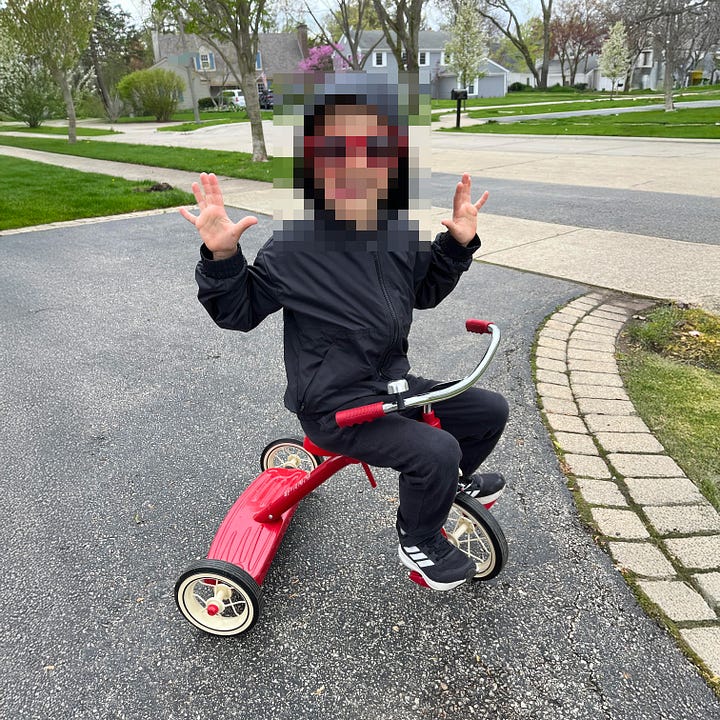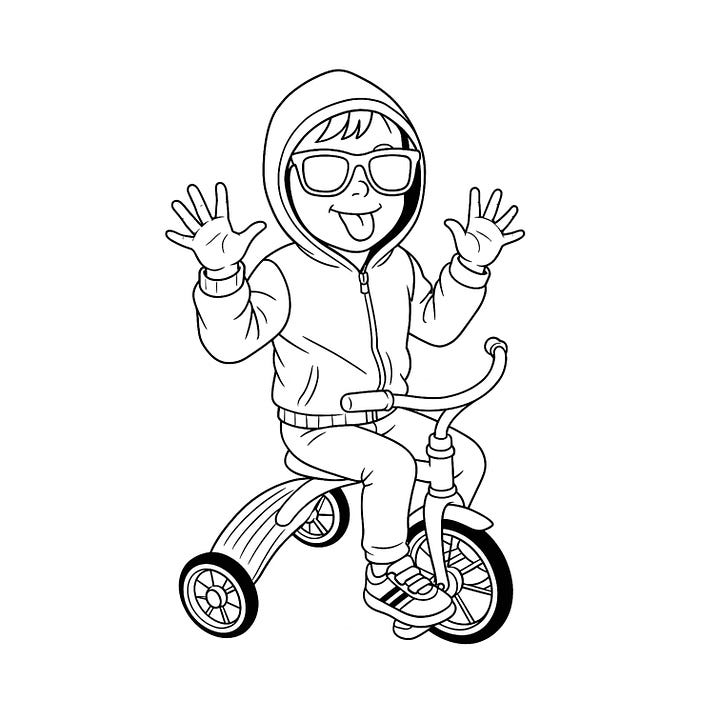The Future Needs Creative Humans
In a world of AI, creativity paired with authenticity will define tomorrow’s careers.
Hey, Friends! In this week’s post, I both suggest a fun AI-assisted project and make predictions about a potentially dystopian future brought on by AI-assisted job displacement. It’s a mixed bag! Let’s get into it,
NPH
Neil Patrick Harris is one of the few child stars who seemingly didn’t lose his mind after finding fame early. Having navigated the minefield of early stardom safely into adulthood, I’m inclined to believe he possesses a wisdom worthy of taking seriously.
In a recent interview on Gary Vaynerchuk’s podcast, he said this:
The two tenets that I hold most important in my whole life are those two words, creativity and authenticity.
See the whole conversation below at 4:32:
As a career and technical education teacher, it’s partly my responsibility to prepare young people for a workforce that is rapidly changing due to artificial intelligence. I write a lot about creativity here because I think it’ll play an important role in shaping that future workforce. Harris’s second tenet, authenticity, may also hold the key to unlocking a future of optimism and abundance.
AI is already displacing many knowledge-based careers, and increasingly, it’s creeping into creative fields too. So, where does that leave us? I hold two thoughts at once:
Creative people may have to completely reimagine the future and invent new careers, perhaps ones that leverage AI, not compete with it.
The creative work we’ve enjoyed for millennia—music, sculpture, painting, storytelling—will continue to thrive.
No one really knows exactly how language models and generative tools work. The fact that they can “paint” in the style of Van Gogh in just a few seconds is neat, but the work is often hollow, and actually makes me respect more the artist who has developed their craft and artistic instincts to be able to produce something aesthetically comparable.
By definition, generative AI is derivative, and in the most extreme case, the opposite of authentic. But humans yearn for genuine connection and authenticity.
One of the reasons Neil Patrick Harris has enjoyed a decades-long career is that he seems like a guy you’d genuinely want to hang out with. Perhaps he’s just an amazing actor, but more than likely, that’s just his authentic self. The more we can shape the future to be like NPH, creative and authentic, the better off we’ll be.
Takeaway: If you’re in the habit of sharing creative work, it's just as important to share your process. It’s one way others get to know your authentic self.
Break The Rules Like Mr. Bean
If you’ve never seen Rowan Atkinson, AKA Mr. Bean, play the air drums, do yourself a favor and watch the video below (it really gets swinging at 1:37).
What stands out to me is that he clearly knows how to actually play the drums despite his drum set being imaginary. His every motion perfectly matches the sound of drums playing over the loudspeakers. Comedically, the bit wouldn’t work if he were just flailing about. It’s only funny because his pantomimed playing is flawless.
In most creative fields, rules and conventions exist that practitioners genuinely follow. One of the most important rules, however, is understanding when it’s ok to break those rules. To do so effectively, you first need to master them. Atkinson’s air drum solo is a perfect example of this.
He breaks probably the most important rule of playing drums—having drums to actually play—but he does so with such skill and creativity that it’s nearly impossible not to be impressed.
Whether it’s Picasso painting in abstraction, Miles Davis playing behind the beat, or Tarantino telling a story non-linearly, breaking conventions moves fields forward.
Takeaway: Understand the rules, then find the courage to push beyond their known limitations.
Fun With AI
Text-to-image generators are ethically questionable, especially for professional creative purposes, but it seems to me they’re going to be part of the designer’s toolkit going forward. So it’s probably a good idea to familiarize yourself with them, even if you later choose not to use them.
To ease the ethical burden of using such tools, I’ve come up with a personal project (one you won’t profit from) to help you explore what’s possible with AI: turn a funny picture from your camera roll into a coloring page.
Below is an example I did with a silly picture of my son (face intentionally blurred here for privacy reasons):


There’s not much to it. Fire up ChatGPT, upload an image of your choice, and enter the prompt below:
Can you make a coloring page that is inspired by this photograph? It should have a white background and clear lines for a kid to color in. ChatGPT nailed it on the first attempt. My son loved the personalized touch, and I loved how excited he was to color in a picture of himself.
Society is still sorting out what to make of AI that feels an awful lot like, but isn’t exactly the same as, intellectual property theft. It might be best to refrain from using it in your professional work for now, but that doesn’t mean you should pretend it doesn’t exist.
Takeaway: Personal projects provide the opportunity to explore new ideas, techniques, and concepts with far fewer consequences than in your professional work.
Empathy
In the startup and tech world, Paul Graham is seen by many as a fountain of wisdom, spouting sage advice, usually in the form of a Tweet. He founded the world’s leading startup accelerator, Y-Combinator, made a zillion dollars, and then left the day-to-day of the rat race to raise a family, read, and write.
Back in February, he said this:
The classic software startup writes code to solve users' problems. If AI makes writing code more of a commodity, understanding users' problems will become the most important component of starting a startup. But it already is.
See the original post below:
In 2012, the same year that Facebook acquired Instagram for $2 billion, another company by the name of iHandy found success with its flashlight app. In the early days of the iPhone, the flashlight was not yet built into the operating system, the app store was still relatively new, and users were eager to get the most out of their devices.
Clever developers at the company realized the LED flashlight built into the rear-facing camera could be left on and used in a utilitarian fashion. The app quickly rose to the top of the app store leaderboards and made the company millions from ad revenue and premium tier app purchases.
While success in technology sometimes involves pushing the boundaries of social media, virtual reality, and smart contracts, at its core is meeting the needs of its users. As AI makes software development more accessible than ever, the ability to empathize with the needs of users will grow in importance, too.
Takeaway: Creative innovation starts with empathy. Ask what problems actually exist and then build solutions to address those problems.
Get Started
In James Clear’s weekly email, he said this about accomplishing great things:
Nearly everything awesome takes longer than you think. Get started and don’t worry about the clock.
It reminded me of another quote attributed to radio host and self-development pioneer Earl Nightingale:
Don't let the fear of the time it will take to accomplish something stand in the way of your doing it. The time will pass anyway; we might just as well put that passing time to the best possible use.
Both quotes speak to the idea that anything worth doing will generally take a while to accomplish. The thing is, there’s really only one way to reliably reduce the amount of time left on a project, and that is by breaking the project into smaller parts and then completing those smaller parts one by one.
The enormity of certain projects, like writing an entire novel, can be paralyzing. When you break a full novel into several different sections, though, and then break those sections into chapters, and then those chapters into paragraphs, and those paragraphs into sentences, all of a sudden, writing a single sentence doesn’t seem so daunting.
Yes, it might take ten years of writing just one sentence a day to complete a full novel, but it’s likely that after you write just one, you’ll want to write another. And even if it does take ten years, ten years will pass no matter what. You might as well end up with something you’re proud of.
Takeaway: If you’ve been struggling to get started on a project because it feels too big, determine what the smallest unit of productivity is, and then do it. Then do that again until you’re done.
Two More Things
I wrote a novella called Windsor Greetings. I’m publishing it here on Substack, and you can check it out here. I’d love it if you gave it a read and then checked back on Tuesday for chapter 5.
Also, if you’re reading this on the Substack app, clicking the like and restack button goes a long way to helping surface this newsletter to other readers. It’d be super cool of you to click those buttons.
I’ll see you in your inbox again next week.
Until then,
-Mike






Love the coloring page idea with AI.
And as always, many great insights packed in one newsletter!